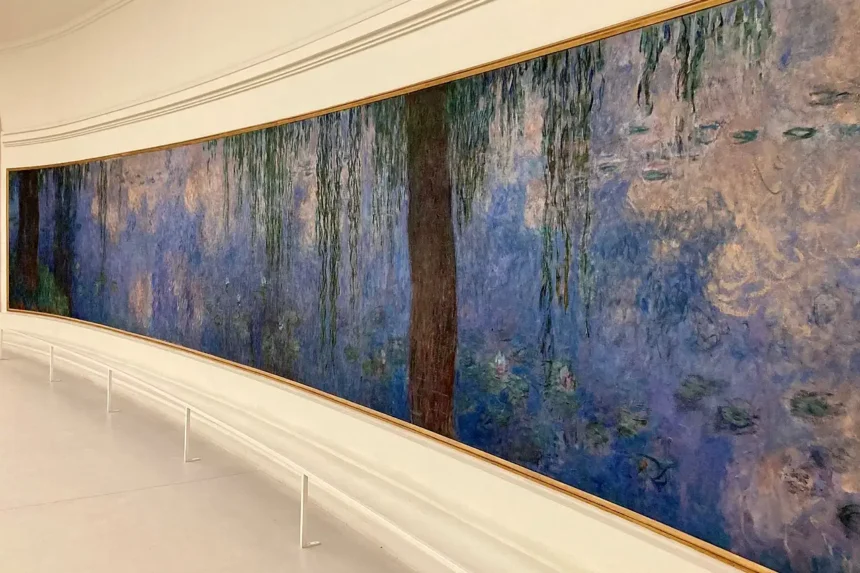Nestled in the heart of Paris, amidst the picturesque Jardin des Tuileries, the Musée de l’Orangerie awaits art enthusiasts and curious travelers alike. This jewel of a museum offers an intimate and immersive experience, most notably with Claude Monet’s breathtaking Water Lilies series. As you step into the specially designed Oval Rooms, you’ll be enveloped by the serene beauty of these monumental canvases, their colors and textures dancing in the natural light. But the Orangerie is more than just Monet; it houses a remarkable collection of Impressionist and Post-Impressionist masterpieces, from Renoir’s vibrant bathers to Cézanne’s groundbreaking landscapes. Join us as we delve into the artistic treasures of the Musée de l’Orangerie and explore the surrounding attractions that make this corner of Paris a must-visit for any art lover or traveler seeking a taste of Parisian charm.
Monet’s Water Lilies: Immersive Oasis
The Musée de l’Orangerie is renowned for housing Claude Monet’s monumental Water Lilies series. These eight vast canvases envelop you in a world of serene beauty. The soft, dappled light and the gentle curves of the lilies create a truly immersive experience, transporting you to Monet’s tranquil garden at Giverny.
The Oval Rooms, designed specifically to showcase the Water Lilies, offer a unique perspective. The natural light filtering through the ceiling washes over the paintings, enhancing their ethereal quality. As you wander through these rooms, you’ll be mesmerized by the ever-changing play of light and color on the canvases.
Don’t rush through this experience. Take your time to absorb the details of each painting. Notice the delicate brushstrokes, the subtle variations in tone, and the overall sense of harmony. Allow yourself to be enveloped by the serenity of Monet’s masterpiece.
Oval Rooms: Designed for Masterpieces
The Musée de l’Orangerie’s Oval Rooms are a testament to the harmonious relationship between art and architecture. These elliptical spaces were meticulously conceived by Monet himself to create the perfect environment for his Water Lilies. The gentle curves of the walls echo the organic forms of the paintings, while the diffused natural light enhances their ethereal beauty.
As you enter the Oval Rooms, you’ll feel a sense of tranquility and peace wash over you. The soft light and the gentle curves of the walls create an atmosphere of contemplation and introspection. The paintings seem to come alive, their colors and textures dancing in the light.
Take a moment to appreciate the architectural details of the Oval Rooms. Notice the elegant proportions, the subtle use of materials, and the overall sense of harmony. These spaces are a true masterpiece in their own right, a perfect complement to Monet’s Water Lilies.
Sunlight & Reflections: Architectural Magic
The Musée de l’Orangerie’s architecture plays a crucial role in enhancing the experience of Monet’s Water Lilies. The Oval Rooms are bathed in natural light, which filters through the ceiling and washes over the paintings. This ever-changing light creates a dynamic and immersive experience, as the colors and textures of the paintings seem to shift and change throughout the day.
The reflections in the water of Monet’s paintings also play a significant role in the overall effect. The shimmering surface of the water captures the light and reflects it back onto the lilies, creating a sense of depth and movement. The reflections also add a layer of complexity to the paintings, as they distort and fragment the images, creating a sense of mystery and intrigue.
Take a moment to appreciate the interplay of light and reflections in the Oval Rooms. Notice how the light dances on the surface of the water, how the reflections distort and fragment the images, and how the colors and textures of the paintings seem to shift and change throughout the day. This is a truly magical experience, one that will stay with you long after you leave the museum.
Beyond Monet: Impressionist Treasures
While Monet’s Water Lilies are the undeniable stars of the Musée de l’Orangerie, the museum also boasts an impressive collection of other Impressionist masterpieces. Wander through the galleries to discover works by Renoir, Cézanne, Matisse, Picasso, and other luminaries of the art world. Each painting offers a glimpse into the artistic movements that shaped the late 19th and early 20th centuries.
Delve into the world of Renoir, known for his vibrant depictions of Parisian life and his sensuous portraits of women. Marvel at the bold brushstrokes and vivid colors of Cézanne’s landscapes and still lifes. Explore the expressive forms and vibrant colors of Matisse’s paintings, which paved the way for modern art. The Musée de l’Orangerie offers a rich tapestry of artistic styles and techniques, inviting you to explore the diverse world of Impressionism and its legacy.
As you wander through the galleries, take note of the different artistic approaches, the interplay of light and shadow, and the emotional impact of each painting. The Musée de l’Orangerie is a treasure trove of artistic expression, offering a fascinating journey through the evolution of modern art.
Renoir’s Bathers: Joyful Abundance
Pierre-Auguste Renoir’s series of bather paintings are a highlight of the Musée de l’Orangerie’s collection. These exuberant canvases celebrate the female form, capturing the joy and sensuality of the human body. Renoir’s bathers are often depicted in natural settings, surrounded by lush vegetation and bathed in warm sunlight.
The paintings are characterized by their vibrant colors, their loose brushstrokes, and their sense of movement. Renoir’s bathers are not idealized figures, but rather real women with curves and imperfections. Their bodies are full of life and energy, and they exude a sense of confidence and joy.
As you admire Renoir’s bathers, notice the way the light plays on their skin, the way their bodies curve and flow, and the overall sense of exuberance that emanates from the paintings. These canvases are a celebration of the female form, a testament to the beauty and power of the human body.
Cézanne & Matisse: Modern Foundations
The Musée de l’Orangerie’s collection also includes significant works by Paul Cézanne and Henri Matisse, two artists who played a pivotal role in the development of modern art. Cézanne’s landscapes and still lifes are characterized by their geometric forms, their bold use of color, and their sense of depth and perspective. His paintings laid the groundwork for Cubism and other avant-garde movements of the 20th century.
Matisse’s paintings, on the other hand, are known for their expressive use of color, their simplified forms, and their focus on decorative patterns. His work challenged traditional notions of perspective and representation, paving the way for abstract art. The Musée de l’Orangerie offers a unique opportunity to explore the contrasting styles of Cézanne and Matisse, two artists who pushed the boundaries of artistic expression and helped to shape the course of modern art.
As you compare and contrast the works of Cézanne and Matisse, notice the different ways they approach form, color, and composition. Consider how their paintings reflect the changing cultural and artistic landscape of the early 20th century. These two artists represent two distinct paths in the evolution of modern art, and their works continue to inspire and challenge viewers today.
Smaller Galleries: Hidden Gems Await
Don’t miss the smaller galleries tucked away within the Musée de l’Orangerie. These intimate spaces house a collection of diverse works, from Post-Impressionist paintings to modern sculptures. Discover hidden gems by artists like Modigliani, Soutine, and Derain, each offering a unique perspective on the artistic landscape of the early 20th century.
The smaller galleries provide a welcome contrast to the grandeur of the Oval Rooms. Here, you can explore a wider range of artistic styles and techniques, from the expressive portraits of Modigliani to the vibrant landscapes of Soutine. These lesser-known works offer a fascinating glimpse into the artistic ferment of the early 20th century.
As you wander through the smaller galleries, take your time to appreciate the nuances of each artwork. Notice the subtle details, the interplay of light and shadow, and the emotional impact of each piece. These hidden gems are a testament to the richness and diversity of the Musée de l’Orangerie’s collection.
Visiting the Musée: Practical Tips
To make the most of your visit to the Musée de l’Orangerie, here are some practical tips. The museum is located in the heart of Paris, within the Jardin des Tuileries. It is easily accessible by public transportation, with several metro and bus lines stopping nearby. The museum is open every day except Tuesdays, and it is advisable to purchase your tickets in advance online to avoid long queues.
Once inside the museum, start your visit with the Oval Rooms, where you can immerse yourself in the beauty of Monet’s Water Lilies. Then, explore the other galleries at your own pace, taking time to appreciate the diverse range of artworks on display. The museum also offers audio guides and guided tours, which can provide additional insights into the collection.
Before you leave, be sure to visit the museum shop, where you can find a wide range of books, postcards, and other souvenirs. The museum also has a café, where you can relax and enjoy a cup of coffee or a light meal.
Nearby Attractions: Tuileries Garden
After your visit to the Musée de l’Orangerie, take some time to explore the Jardin des Tuileries, one of Paris’ most iconic gardens. This sprawling green space is a popular spot for both locals and tourists, offering a peaceful retreat from the hustle and bustle of the city.
Stroll along the tree-lined paths, admire the colorful flower beds, and relax by the tranquil ponds. The garden is also home to several sculptures, including works by Maillol and Rodin. During the summer months, the garden hosts a variety of events, including concerts and outdoor film screenings.
The Jardin des Tuileries is a perfect place to unwind after your visit to the museum. Take a moment to soak up the atmosphere, admire the beauty of the surroundings, and reflect on the art you have just seen.
Jardin des Tuileries: A Parisian Retreat
The Jardin des Tuileries is more than just a garden; it’s a quintessential Parisian experience. From the moment you step through the gates, you’ll be transported to a world of elegance and tranquility. The meticulously manicured lawns, the perfectly trimmed hedges, and the elegant fountains create a sense of harmony and order.
As you stroll through the garden, you’ll encounter a variety of attractions. Admire the majestic Arc de Triomphe du Carrousel, a triumphal arch that commemorates Napoleon’s victories. Relax by the Bassin Octogonal, a large octagonal pond that is a popular spot for boating. Or simply find a bench and soak up the atmosphere of this iconic Parisian landmark.
The Jardin des Tuileries is a place where you can escape the crowds and enjoy the simple pleasures of nature. It’s a place where you can recharge your batteries and reconnect with your inner peace.
Cafés & Bistros: Fueling Your Art Day
Exploring the Musée de l’Orangerie and the Jardin des Tuileries is sure to work up an appetite. Luckily, the surrounding area is filled with charming cafés and bistros where you can refuel and indulge in some delicious French cuisine.
Whether you’re looking for a quick espresso and a croissant or a leisurely lunch of steak frites and a glass of wine, you’ll find plenty of options to suit your taste and budget. Many cafés offer outdoor seating, so you can enjoy your meal while soaking up the Parisian atmosphere.
Don’t hesitate to ask the locals for recommendations on the best places to eat. They’ll be happy to share their favorite spots with you.
Souvenirs & Gifts: Artful Memories
Before you leave the Musée de l’Orangerie, be sure to visit the museum shop. Here, you’ll find a wide range of souvenirs and gifts inspired by the museum’s collection. From postcards and posters to books and jewelry, there’s something for everyone.
You can also find a selection of reproductions of Monet’s Water Lilies, as well as other Impressionist masterpieces. These make for beautiful and unique gifts, and they’re a great way to take a piece of the museum home with you.
The museum shop is a great place to find a special memento of your visit to the Musée de l’Orangerie. Whether you’re looking for a gift for yourself or for a loved one, you’re sure to find something special here.











